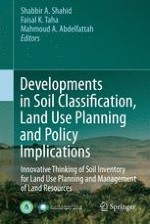2013 | OriginalPaper | Buchkapitel
4. Do the Emerging Methods of Digital Soil Mapping Have Anything to Learn from the Geopedologic Approach to Soil Mapping and Vice Versa?
verfasst von : Abbas Farshad, Dhruba Pikha Shrestha, Ruamporn Moonjun
Erschienen in: Developments in Soil Classification, Land Use Planning and Policy Implications
Verlag: Springer Netherlands
Aktivieren Sie unsere intelligente Suche, um passende Fachinhalte oder Patente zu finden.
Wählen Sie Textabschnitte aus um mit Künstlicher Intelligenz passenden Patente zu finden. powered by
Markieren Sie Textabschnitte, um KI-gestützt weitere passende Inhalte zu finden. powered by
